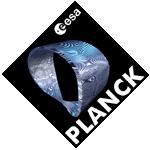|
The key scientific objectives of PLANCK are as follows:
- Measurements of the CMB anisotropies to an accuracy of
 T/T~10-6
over a wide range of angular scales (10' -- 180o);
this will allow a determination of fundamental parameters such as the spatial curvature, Hubble constant
and the baryon density, to a precision of a few percent. T/T~10-6
over a wide range of angular scales (10' -- 180o);
this will allow a determination of fundamental parameters such as the spatial curvature, Hubble constant
and the baryon density, to a precision of a few percent.
- Tests of inflationary models of the early universe; specifically the determination of the spectral index of the primordial fluctuation
spectrum to high precision and the possible detection of a component of the CMB anisotropies induced by primordial gravitational waves,
which would show conclusively that the Universe passed through an inflationary phase.
- The detection of characteristic signatures in the CMB created by topological defects, such as cosmic strings and textures,
generated at a phase transition in the early Universe.
- To measure the amplitude of structures in the CMB with physical scales smaller than
~100h-1(requiring an angular resolution of better than 1o) which have sizes comparable to the voids and
filaments observed in the galaxy distribution today. By comparing PLANCK measurements with new redshift surveys
of ~106 galaxies it will be possible to determine the evolution of cosmic structure and constrain the nature of the dark matter in Universe.
- Measurements of the Sunyaev-Zeldovich effect -- temperature anisotropies which are caused by the frequency
change of microwave background photons scattered by hot electrons in the gaseous atmospheres of rich clusters of galaxies.
PLANCK will detect this effect in many thousands of rich clusters, providing information on the physical state of the intracluster
gas and on the evolution of rich clusters. These measurements can also be combined with spatially resolved X-ray observations
to estimate the Hubble constant H0.
- Using the high sensitivity of PLANCK and the sub-mm bolometer channels it will be possible to disentangle the
frequency dependent Sunyaev-Zeldovich effect in rich clusters of galaxies from temperature differences caused by
their peculiar motions. It should be possible to measure cluster peculiar velocities for more than 1000 clusters
to an accuracy of ~250 km/s providing powerful tests of theories of structure formation and on the mean mass density of the Universe.
- PLANCK will produce high sensitivity maps over 95% of the sky over a wide range of frequencies which have
never before been studied at such high resolutions and sensitivities. These maps will have a large number of applications,
from studies of synchrotron emission in our Galaxy, star-forming regions, Galactic dust and the interstellar medium to
the origin of the far-infrared background and the evolution of infrared luminous galaxies at high redshifts. In particular,
- the comparison of maps of the free-free emission and the dust emission will allow to study the relative distribution
of the ionized vs the neutral interstellar medium;
- the synchrotron emission at high frequency will constrain the cosmic ray electron and magnetic field distributions;
- the anisotropies of the far infrared background, together with a survey of point sources, will constrain models of galaxy formation.
The Planck Scientific case is described in details
here
|



